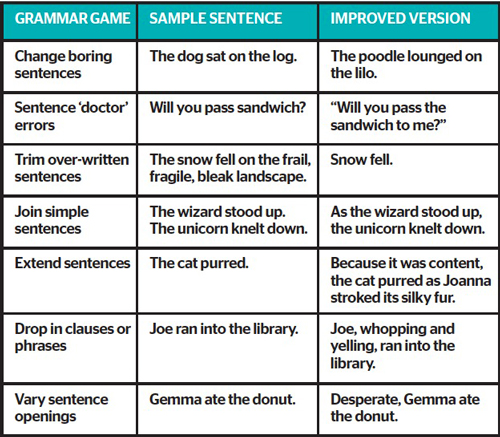There’s no need to panic about the new ‘SPAG’ test, says Pie Corbett. Just carry on teaching children to read and write effectively, and experiment with punctuation and spelling in context...
Grammar fever has hit the country. There is to be a grammar test. If you have had a glance at the test, you will have realised that there is nothing to panic about. If children have been taught well they will easily be able to cope with the sorts of questions that are being asked. Twenty per cent of the questions are about the ability to identify a grammatical feature such as ‘circle the adverbs’. The rest of the questions are all about grammatical usage and accuracy. This is tested through being able to punctuate accurately or select the right word to fit into a sentence, for instance ensuring verb agreement.
Some of the aspects in the draft curriculum are pointless and not worth bothering with. Why anyone needs to know the subjunctive at the age of 11, I have no clue. My guess is that almost every MP would struggle with that. The danger of such silliness is that teachers could be led into wasting time teaching such things, detracting from the crucial business of teaching children to read and write effectively. The danger is that I can envisage schools training children so they do well on a grammar test, but still cannot write.
Grammar in context
Whilst there is no evidence that formal teaching of grammar raises standards in reading and writing, there is some evidence to suggest that teaching it in context can be useful. The key conditions for such teaching would be:
Of course, we have been here before. Many teachers will recall the advent of ‘Grammar for Writing’ that introduced the simple idea that grammar was best learned as an active process, taught as part of writing and reading. It was founded on the concept that grammatical skill comes before genuine knowledge. Grammar may be viewed as a set of skills:
Grammar starters
Lessons should begin with the daily ‘grammar starter’. This will be an aspect of writing that is needed to make progress or part of the text type being studied. Games might include.

During such games, grammatical terminology should be used so that the children gradually build up an understating of different grammatical concepts. Grammar is not really ‘knowledge’; rather it is a matter of grasping a ‘concept’. Keep such teaching simple and clear with the focus on gaining control over words, sentences and the flow of writing.
Joining sentences
One aspect of grammar teaching that has been well-researched and proved to help mature children’s writing is known as ‘sentence combining’. This can be done in different ways. Provide children with several sentences and work on turning them into one sentence.
Begin simply, by asking children to combine two simple sentences together, testing out different conjunctions (I would suggest avoiding ‘and’). For example:
The cart stopped. The hobbit got down.
Becomes…
The cart stopped before the hobbit got down.
List different conjunctions that work, e.g. so, before, after, while, when, whenever, as, as soon as, until, because, as long as…Move on to experimenting, by linking more sentences
Becomes…
The marmalade cat crept cautiously along the wall.
Experiment by using instructions.
Experiment further by asking children to combine many simple sentences, perhaps creating several complex sentences. Always discuss ‘what works’.
Spelling rules
Spelling rules and mnemonics can help some children, as long as there are not too many rules to remember. In the main, most of us remember how to spell from plenty of reading, which builds our visual memory of key patterns. Use simple, daily games to reinforce key spellings patterns and exceptions. The spellings should be in relation to the text type or what is needed for progress.

Create a school system
The new curriculum specifies what is to be taught and it is important to organise this into a school system so that it is crystal clear what has to be introduced and taught in each year group. Within a key stage there is room for manoeuvre, so that you can introduce key aspects in different year groups as you wish. Create a simple grid that shows what has already been introduced and will need revisiting as well as new aspects to teach. Make sure that the teaching is not through grammar exercises, rather teachers ‘exercise’ grammar through its constant use in writing and reading. There is no evidenced to suggest that grammar exercises work. Also include in this grid the spelling work that has to be taught and applied each year.
How to be a singing school
Ace-Music
